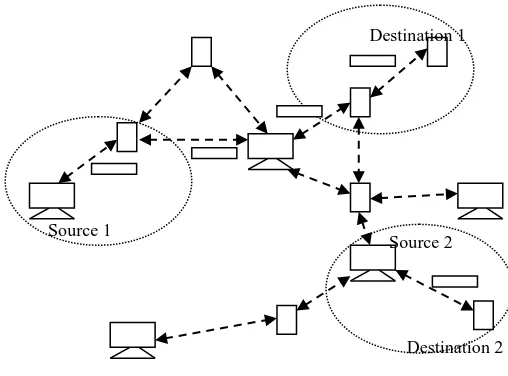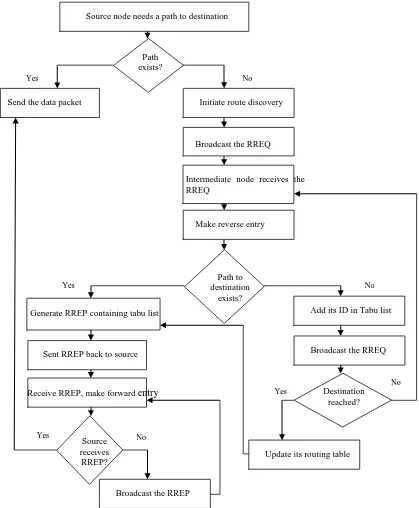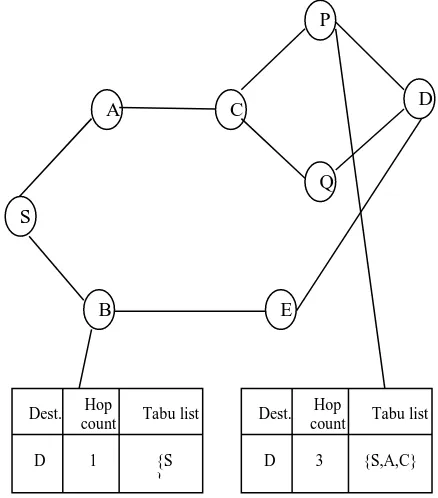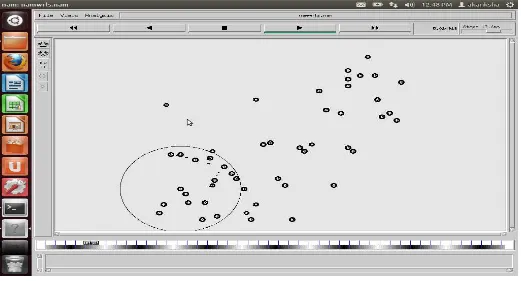Ad Hoc On-Demand Multipath Distance Vector
Routing Protocol with Route Repair for MANET
Ayushi Varshney
Department of Computer Science & Engineering Ajay Kumar Garg Engineering College
Ghaziabad, India [email protected]
Prachi Maheshwari
Department of Computer Science & Engineering Ajay Kumar Garg Engineering College multipath distance vector routing protocol. The modified protocol finds the multiple disjoint paths between the source and destination and uses an efficient approach to repair the failed available, route discovery is re-initiated which degrades the performance of routing protocol. To solve this problem, the modified protocol provides the multiple disjoint paths along with local route repair approach.
Keywords—Ad hoc network; Routing Protocol; DSR; AODV; AODV-BR; AOMDV; AOMDV with local route repair
I. INTRODUCTION
The wireless network consists of wireless devices and each device is capable of exchanging the data packet to each other. There are two types of wireless network: Infrastructure wireless network and Infrastructure less wireless network (Ad hoc network) [3]. Infrastructure network – In infrastructure wireless network, there is a fixed base station or access point to which all the devices are connected through wire and each device is in the range of base station. Infrastructure less network – Ad hoc network is infrastructure less, self organized and autonomous network of mobile nodes which do not depend upon any access point or base station. Each node acts as both router as well as host [2].
The mobile ad hoc network (MANET) is the collection of wireless mobile nodes. Like wired network, wireless network also contains the router and host. The main difference between the wired and wireless network is their way of communication [12]. The ad hoc network does not have any fixed infrastructure but provides the connectivity among the nodes. In MANET, a node can act as a router for forwarding the packets in the network as well as host. The node can communicate with other node if they are in each other
transmission range otherwise they use multi-hops for their communication as shown in figure 1.
Fig. 1. Transmission in Ad Hoc Network
The MANET exhibits the following characteristics: Infrastructure less, autonomous terminal, multihop routing, dynamic network topology and energy constrained [13]. MANET is used in variety of application such as military battlefields, emergency services, civilian and commercial environment, education and many more [14].
The nodes in the ad hoc network are free to move in any direction. The ad hoc network are easy to deploy and useful when infrastructure is absent or destroyed. The routing protocols establish the path between the communicating nodes. The routing protocols are responsible for maintaining path till the communication ends. The path must be optimal in terms of number of hops or distance. To provide the communication, several routing protocols have designed. The routing protocols are classified into proactive, reactive and hybrid [1].
Proactive protocols continuously exchange the topology information among the nodes in order to learn the topology of the network and when the route is required to destination then route is immediately obtained [10]. Some examples of
Source 1
Source 2 Destination 1
proactive routing protocols are: Destination Sequence Distance Vector (DSDV), Global State Routing (GSR), and Hierarchical State Routing (HSR). Reactive protocols are on-demand, when the route is required to destination; the route discovery process initiates [11]. Some examples of reactive routing protocols are: Dynamic Source Routing (DSR), Ad hoc On-demand Distance Vector Routing (AODV) and Temporary Ordered Routing Protocol (TORA). Hybrid protocols incorporate the important feature of both proactive protocol and reactive protocols. The example of hybrid routing protocol is Zone Routing Protocol (ZRP).
Reactive protocols are used over proactive protocols due to following reason: mobility increases, route concentration decreases and number of active routes per node decreases and route activity decreases. The reactive and proactive routing protocols are classified into unipath and multipath routing protocols [2]. The unipath routing protocols discover the single path between the source and destination. Some unipath routing protocols are DSR, DSDV, AODV. The multipath routing protocols discover the multiple paths between the source and destination. Some multipath routing protocols are AODV-BR, AODVM and AOMDV.
The multipath routing protocols performed well in comparison of unipath routing protocols. The advantage of using the multipath routing protocols over unipath routing protocols are [2]: (i) The multipath protocols provide the backup route in case of route failure. (ii) Multipath protocols provide better load balancing in comparison to unipath protocols. Due to the mobile nature of nodes unipath routing protocols are not sufficient for routing the data packets. The number of multipath routing protocols has been proposed. These protocols form the alternate path along with the primary path. When the primary path fails, the alternate path is used for sending the data packets from source to destination. If no alternate path is available and route is still required for introduces a modified AOMDV with local route repair routing protocol (AOMDVL). The AOMDVL react quickly to link failure by using the tabu list [9] concept. The main idea behind repairing the failed route is to connect the two parts of the failed route with minimum overhead. The end-to-end delay is also reduced by this approach.
The remaining paper is organized as follows: section II presents the related work. The modified AOMDV with local route repair is discussed in section III. Section IV and V present the performance evaluation and results of AOMDVL. The conclusion of this paper is present in section VI.
II. RELATED WORK
A. DSR
Dynamic source routing is on demand protocol. DSR is
the unipath protocol. DSR has two main components. One component is route discovery and second is route maintenance. In route discovery, when a node wants to send the data packet to other node in the network then the sending (source) node first check its route cache for the valid route to destination node. If path exists in its cache then data is send through that path otherwise the source node generate the route request (RREQ) and broadcast RREQ message to its neighbours to find the valid route to destination. When an intermediate node receives the RREQ it broadcast to its neighbours. When destination or intermediate node having path to destination receives the RREQ then it generate the route reply (RREP) message and unicast back to source node. Once the path to destination is discovered then source node uses that path to send the data packets. In route maintenance, when the link in the active path break then the rout error message (RERR) is generated by the failure sensed node and unicast to source node. The path from the route cache of nodes is deleted corresponding to which the RERR message is received [5,7].
B. AODV
The ad hoc demand distance vector is the pure on-demand multipath unipath routing protocol. In AODV protocol, the nodes do not maintain and discover the path until it is required. AODV performs the on-demand route discovery like DSR and uses the concept of sequence number from DSDV. By using this combination AODV make efficient use of bandwidth and also reduce the routing overhead. The node initiates the route discovery when the path is required and path is not available in its routing table. The source node initiates the route discovery process by generating the RREQ (route request) message and broadcast to its neighbors. The RREQ contains the following: <source IP address, source sequence number, broadcast ID, destination IP address, destination sequence number, hop count>. When an intermediate node receives RREQ, it checks whether the same RREQ already received or not. If RREQ is already received then the node dropped the duplicate RREQ otherwise makes reverse entry in its routing table and check the table for valid path to destination in its table. If the path exists then the node generates the RREP (route reply) and sent back to the source node otherwise re-broadcast the same RREQ to its neighbor. When the destination node receives the RREQ then it makes the reverse entry and generates the RREP. Through the reverse path the RREP is sent to the source node. When source node receives the RREP, the path is established and then source node sends the data packets through the discovered path. During the route maintenance, when any node detect the link failure then it send the RRER (route error) message to the source node. After receiving the RERR, the source node re-discovers the path to destination, if still required [4, 3].
C. AODV-BR
Fig. 2. Route Discovery process of AOMDVL
route discovery process of AODV. Like in AODV, the source node broadcast the route request (RREQ) message to its neighbor in order to find the route. When an intermediate node receives the RREQ message it stores the hop and source node information then broadcast the RREQ. When the destination receives the RREQ message, it generates the route reply (RREP) and sends back to the source node. For the later received RREQ message, the destination sends the RREP
messages. AODV-BR maintains the two routing tables: primary table and alternate table. Only one path is chosen at a time known as primary path. When the primary path fails, the alternate path is used for data delivery [7, 8].
D. AOMDV
The main concept of AOMDV is to discover the multiple paths between the single source and destination. The main
Source node needs a path to destination
Path exists?
Send the data packet Initiate route discovery
Broadcast the RREQ
Intermediate node receives the RREQ
Make reverse entry
Path to destination
exists?
Generate RREP containing tabu list Add its ID in Tabu list
Broadcast the RREQ Sent RREP back to source
Destination reached? Receive RREP, make forward entry
Source receives RREP?
Broadcast the RREP
Update its routing table
Yes No
Yes No
Yes
No
Fig. 3. Route repair process of AOMDVL
objective behind the design of AOMDV routing protocol is to provide better fault tolerance. In case of single path routing protocol such as AODV, when any route failure occur the source node again initiates the route discovery if path still required which results in increase of routing overhead and latency. To reduce this inefficiency AOMDV discovers the multiple paths in single route discovery process. AOMDV is the extension of AODV routing protocol. AOMDV forms the multiple link-disjoint and loop-free paths. Link disjoint are the
paths which have no link in common but nodes can be common. The route discovery process of AOMDV works similarly as existing AODV routing protocol but with some modifications. In AOMDV the duplicate RREQ are not immediately discarded by the nodes. These duplicate RREQs are further examined to form the multiple disjoint paths. The RREQs coming through the different neighbors of the source node ensures the node-disjointness. In order to form the link disjoint paths, the destination node replies to each replica of
Start
No action
Send the data packet Generate REPAIR packet
Drop the packet Already REPAIR
packet received?
Node ID already exists in tabu list?
Path to destination exists? Broadcast the REPAIR packet Route failed?
Another route exists?
Intermediate node receive the REPAIR
TTL reached?
Generate RREP containing tabu list
Sent RREP to originator of REPAIR packet
Receive RREP and make forward entry
Originator node receives RREP?
Add its node ID in tabu list
Broadcast the REPAIR packet
Destination reached?
No
Yes
Yes No
Yes
No
No
No
No Yes
Yes
Yes
Yes
Yes
No
RREQs reached by the different neighbors. The RREP then follows the reverse path which is node disjoint and thus link disjoint. At any intermediate node the RREP may overlaps but following the reverse path ensures the link disjointness. When multiple paths are formed the source node selects the single path for data transmission. When this path fails then alternate path is picked from the routing table for the further transmission. In case when no alternate path is available then the RERR message is sent back to source node. The source node reinitiates the route discovery process if path is still required [1, 15].
III. PROPOSED WORK
In this paper, we present the modified AOMDV with local route repair technique (AOMDVL). The modified protocol also discovers the multiple paths like AOMDV but also provide an effective and efficient local route repair technique. In AOMDVL routing protocol, when any path fails then node selects the alternate path with less number of hops. If two or more paths have same number of hops then on the basis of signal strength the best alternate path is selected for the packet transmission. In AOMDV, the RERR message is sent back to the source node to re-initiates the route discovery when no alternate path is available. In the proposed AOMDVL routing protocol, the routing table also stores the tabu list. The tabu list is maintained during the route discovery process. The AOMDVL protocol consists of two phases: route discovery and route repair. The route discovery process is similar to the AOMDV except, each node maintains the tabu list. After receiving the RREQ, each node adds its own ID in the tabu list and at the time of RREP node drops its own ID from the tabu list. Figure 2 illustrates the flowchart of route discovery phase of AOMDVL.
During the route repair phase, when no alternate path is available then the failure sensed node generates the REPAIR message and broadcast it. The REPAIR message contains the tabu list stored in the routing table of the originator node. The tabu search algorithm prevents the REPAIR packet from going to the upstream nodes of the broken path. When an intermediate node receives the REPAIR packet, it checks the three conditions: (i) the REPAIR packet already received, (ii) node ID already present in the tabu list of REPAIR packet or (iii) TTL reached. If any of the three conditions is true then the node drops the REPAIR packet otherwise check its routing table for the valid path to destination. When destination or intermediate node having path to destination receives the REPAIR packet then it generate the RREP which contains the tabu list and sent back to the originator of the REPAIR message. Figure 3 shows the summarized flowchart of route repair phase of AOMDVL.
The routing table entry of AOMDVL at node is shown in figure 4. The figure shows the routing table information at node B and node P. In the figure S is the source node and D is the destination node. The diagram forms the two disjoint paths: S-B-E-D and S-A-C-P-D. When the S-B-E-D path fails then another path S-A-C-P-D is used for the transmission. In case of the failure of S-A-C-P-D path no alternate path is available then the failure sensed node initiates the local route repair phase.
Fig. 4. Routing table in AOMDVL
IV. PERFORMANCE EVALUATION
To evaluate the performance of proposed algorithm AOMDVL, LINUX environment with the version NS-2.35 of network simulator is used. NS-2.35 is an object oriented simulator which uses the two different languages. At the backend the coding is written in C++ and the tcl interpreter is used at the frontend. For the configuration and set up tcl language is required.
The proposed algorithm is compared with the AOMDV and AODV routing protocols. For the evaluation of proposed scheme, the nodes are deployed in the area of size 1000m X 1000m. Initially nodes are placed randomly in the area. The random way point mobility model is used for the node movement. Pause time is zero second. The source and destination pairs are randomly chosen and several UDP/CBR connections are established between them. The simulation time is 500 seconds. Data packets are of 512 bytes in size. The number of nodes varies from 10 to 50. The summarized simulation parameters are shown in table 1.
The sample screen shot of 50 nodes is shown in figure 5. Following performance metric are chosen for the comparison of AOMDVL with AOMDV and AODV routing protocol.
A. Packet Delivery Ratio
Fig.5. Sample screenshot of 50 nodes
Where Psk is the data packets sent by the source node and Prk is the data packets received by the destination node.
B. Packet loss ratio
The difference between the number of data packets sent by the source node and received by the destination node in the network is defined as packet loss ratio (PLR).
Table 1. Simulation Parameter for evaluation of routing protocols
S No. Parameters Values
1 Area 1000m X 1000m
2 Number of nodes 10-50
3 Propagation range 200m
4 Mobility model Random way-point
5 Simulation time 500s
6 Node speed 10m/s
7 Traffic type CBR
8 Pause time 0
9 Number of experiments 5
10 Packet size 512 bytes
C. Throughput
The total number of packets received in unit time is defined as the throughput.
V. RESULTS
In the simulation, the proposed protocol is simulated and compared with the AOMDV and AODV routing protocol. In simulated scenario, the UDP/CBR connections are varied. In the scenario the number of nodes varies from 10 to 50 which are randomly distributed over area of 1000m X 1000m. The simulation is performed for 500 s. Figure 6 – 8 shows the results of the simulation. The nodes move with the constant speed within the area defined. For the results the PDR, PLR and RO is calculated.
Figure 6 shows the result for packet delivery ratio. The proposed algorithm AOMDVL performs better in comparison to the AOMDV and AODV routing protocols. As AOMDVL has better packet delivery ratio from the AODV and AOMDV routing protocol.
Figure 7 shows the result for the packet loss ratio. The proposed algorithm has less packet loss in comparison to AODV and AOMDV routing protocols. So, AOMDVL also perform better for packet loss ratio from the AODV and AOMDV routing protocol.
AOMDVL also performs better in context to routing overhead from the AODV and AOMDV routing protocols.
Fig. 6. Packet Delivery Ratio
Fig. 7. Packet Loss Ratio
Fig. 8. Throughput
As a result it is found that the proposed AOMDVL routing protocol can successfully discover the routes and forward the data packet through that better the original AOMDV and AODV routing protocols.
VI. CONCLUSION
The paper discusses the working of unipath AODV and multipath AOMDV routing protocol. The paper also presents the modified AOMDV with local route repair technique (AOMDVL). In this paper, the performance of AOMDV with
local route repair, original AOMDV and AODV is analyzed. For the simulation the NS-2.35 is used. The comparison results show that AOMDV with local route repair technique performs better than the original AOMDV and AODV routing protocols. The proposed AOMDVL perform better in terms of PDR, PLR and Throughput.
References
[1] Ayushi Varshney, Prachi Maheshwari, “Review on Reactive On-Demand Unipath and Multipath Routing Protocols”. The International Journal Of Science & Technoledge (ISSN 2321 – 919X), Vol 4 Issue 5 May, 2016.
[2] Uday Singh Kushwaha, P. K. Gupta, S. P. Ghrera, “Performance evaluation of AOMDV routing algorithm with local repair for wireless mesh networks”. CSIT (January 2015) 2(4):253–260 DOI 10.1007/s40012-015-0065-9.
[3] Daxesh N. Patel, Sejal B. Patel, Hemangi, R.Kothadiya, Pinakin D. Jethwa, Rutvij H. Jhaveri, “A Survey of Reactive Routing Protocols in MANET”. 2015, ISBN No.978-1-4799-3834-6/14/$31.00©2014 IEEE.
[4] Ayushi Varshney, Prachi Maheshwari, “Comparative Study of AODV & AOMDV Routing Protocol”. International journal of control theory and applications, Vol. 9, No. 6, 2016.
[5] Sucheta Sharma, Gurpreet Singh, “Simulative Contemplation Of AODV, Aomdvand MDART Protocols”. International Journal Of Advanced Engineering Research And Technology (IJAERT) 2014, Volume 2 Issue 2, ISSN No.: 2348 – 8190
[6] Loay Abusalah, Ashfaq Khokhar, And Mohsen Guizani, “A Survey Of Secure Mobile Ad Hoc Routing Protocols. IEEE Communications Surveys & Tutorials, 2008, Vol. 10, No. 4, Fourth Quarter
[7] Uday Singh Kushwaha, P.K. Gupta, “AOMDV Routing Algorithm For Wireless Mesh Networkswith Local Repair (AOMDV-LR)”. International Conference On Communication And Signal Processing 2014
[8] Ranjeet Kaur, Rajiv Mahajan, Amanpreet Singh, “A Survey On Multipath Routing Protocols For MANETS”. International Journal Of Emerging Trends & Technology In Computer Science (IJETTCS), 2013, Volume 2, Issue 2
[9] Lamri Sayad, Djmail Aissani, Louiza Bouallouche-Medjkoune (2015) On-Demand Routing Protocol with Tabu Search Based Local Route Repair in Mobile Ad Hoc Networks. Wireless Pers Common DOI 10.1007/s11277-015-3081-z
[10]Jyoti Jain, Roopam Gupta, Tushar K. Bandhopadhyaya, “Performance Nalysis Of Proposed Local Link Repair Schemes For Ad Hoc On Demand Distance Vector”. IET Netw., 2013, Vol. 3, Iss. 2, Pp. 129-136
[11]Ranjeet Kaur, Rajiv Mahajan, Amanpreet Singh, “A Survey On Multipath Routing Protocols For MANETS”. International Journal Of Emerging Trends & Technology In Computer Science (IJETTCS), 2013, Volume 2, Issue 2
[12] Meenu Chawla, Jyoti Singhai, J l Rana, “Local Repair with Handoff
Approach for on Demand Routing Protocols in Ad Hoc Networks”.
International Journal of Computer Science & Communication, Vol. 1, No. 2, July-December 2010, pp. 33-40.
[13] Deepesh Namdev, Rajeshwaree Parashar, “An Approach Opted Path Restore Technique for Routing Protocol in Ad-Hoc Network”. Journal of Electronics and Communication Engineering Research, volume 2 – Issue 5 (2014) pp: 01-06, ISSN: 2321-5941.
[14] Mohit Kumar, Rashmi Mishra, “An Overview of MANET: Histoory,
Challenges and Applications”. Indian Journal of Computer Science and





